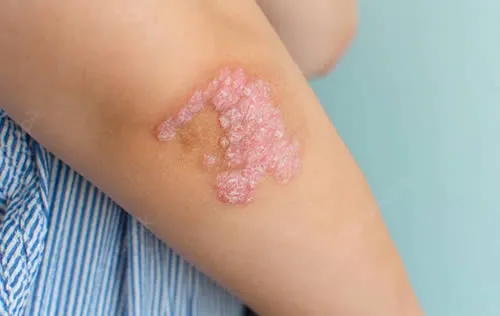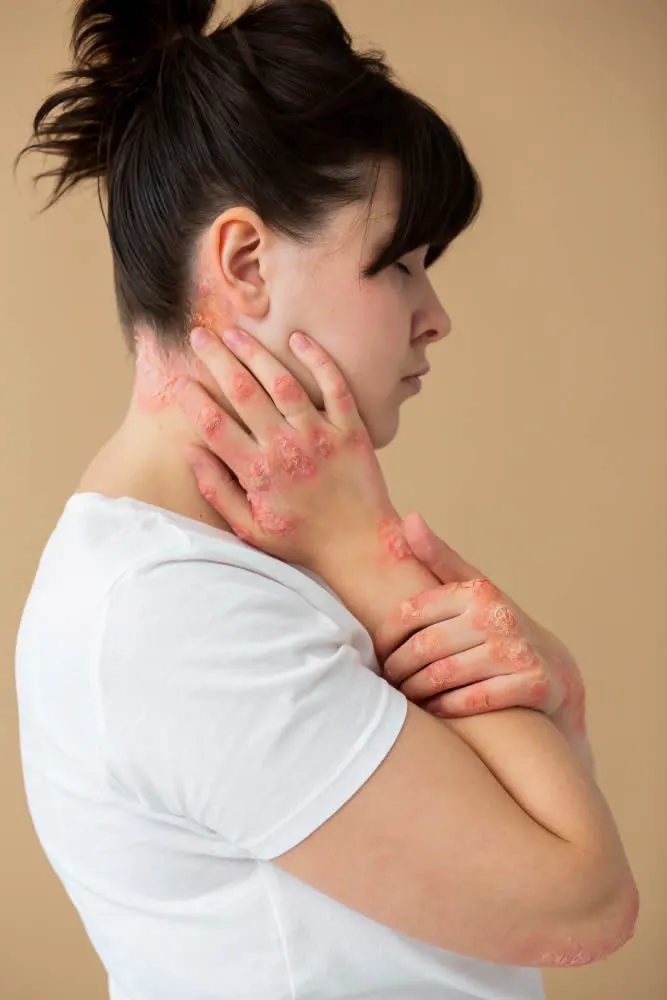What is Psoriasis?
An estimated 7.5 million Americans suffer with psoriasis, a non-contagious, chronic skin condition. Often identified by patches of red, scaly skin, psoriasis occurs when the immune system sends out incorrect signals that cause skin cells to grow too quickly. With psoriasis, cells build up on the top layer of skin, creating patches of itchy, dry skin. The most common locations for psoriasis are on the elbows, knees, or trunk, but it can develop anywhere on the body.
Psoriasis is thought to be an autoimmune disease, which arises from an overactive response by the body towards substances and tissues normally present in the body. In the case of psoriasis, white blood cells, called T cells, attack healthy skin as if to fight off infection or heal a wound. Instead of new cells moving to the outermost layer of skin in a normal manner, they develop more rapidly. The dead skin can’t slough off fast enough to keep up, so thick, scaly areas form on the skin’s surface.
Usually, the first occurrence of psoriasis happens sometime between ages 15 to 35. However, approximately 20,000 children under age 10 also live with psoriasis. Although psoriasis seems to have a genetic component, not everyone with that gene develops the disease.

What are the signs and symptoms of Psoriasis?
Each case differs based on the individual, but people with psoriasis often experience at least one of the following symptoms:
- Burning, itching, or soreness
- Cracked, dry skin that can bleed
- Patches of red skin with silvery scales
- Pitted, ridged, or thickened nails
- Stiff, swollen joints
If you think that you could have psoriasis, contact your doctor and schedule a complete exam.
Triggers
Because psoriasis is chronic, anyone with the condition will live with a cycle of flare-ups and remissions over a lifetime. Typically, patients with psoriasis may develop initial symptoms or experience flare ups because of various triggers, including
- Certain medications
- Cuts, scrapes, burns, or other damage to the skin
- Diet
- Excessive alcohol use
- Other infections such as strep throat
- Smoking
- Stress
- Weather
What are the different types of Psoriasis?
There are six main types of psoriasis:
1) Plaque Psoriasis (Psoriasis Vulgaris)
About 80 percent of people diagnosed with the disease have plaque psoriasis, or psoriasis vulgaris. Plaque psoriasis often appears as on the elbows, knees, and lower trunk in the form of raised, red lesions topped with silvery scales.
2) Guttate Psoriasis
Usually found on the limbs or trunk, guttate psoriasis primarily appears in patients younger than age 30. Guttate psoriasis presents as small, water-drop-shaped sores and can occur because of an illness or injury to the skin.
3) Inverse Psoriasis
With inverse psoriasis, patients develop smooth, shiny lesions that are bright red in color. Most often seen in people who are overweight, inverse psoriasis strikes the armpits, around the genitals, near the groin, and under the breasts.
4) Pustular Psoriasis
When you have pustular psoriasis, white blisters filled with pus and surrounded by red skin will appear either in localized areas or all over your body. Because the pus is made of white blood cells, it is not contagious. Certain things can trigger pustular psoriasis, such as irritating topical treatments, infections, overexposure to ultraviolet radiation, and stress.
5) Erythrodermic Psoriasis
Characterized by a fiery red rash coupled with extreme burning or itching, erythrodermic psoriasis is the least common kind of psoriasis. Triggers for erythrodermic psoriasis include severe sunburn, corticosteroids, other medications, or another type of psoriasis that has flared up.
6) Psoriatic Arthritis
In addition to causing pitted, discolored nails, psoriatic arthritis also presents with the swollen, painful joints that often accompany arthritis. Usually psoriatic arthritis isn’t as crippling as other forms of arthritis, but it can cause stiffness and progressive joint damage.
What treatments are available at the dermatologist for Psoriasis?
Currently, no cure exists for psoriasis. Treatments are designed to minimize discomfort and encourage healing. When determining the best treatment, your doctor will take into account the severity of the psoriasis. Mild to moderate psoriasis covers 3 to 10 percent of your body, while psoriasis is considered moderate to severe when it covers more than 10 percent.
Treating Mild to Moderate Psoriasis
If you have mild to moderate psoriasis, your doctor will likely recommend a combination of over-the-counter medications, prescription topical treatments, and light therapy/phototherapy.
Over-the-Counter (OTC) Medications
The two active ingredients in over-the-counter medications approved by the FDA for psoriasis are coal tar, which inhibits the quick overgrowth of cells, and salicylic acid, which makes the outer layer of skin shed. Other OTC treatments may help, like:
- Scale lifters to loosen and eliminate scales so that medicine can penetrate the sores
- Bath solutions, such as Epsom salts, Dead Sea salts, or oilated oatmeal, that reduce itching and remove scaling
- Occlusion, which covers the areas treated with topical treatments applications, to improve absorption and effectiveness
- Anti-itch products like calamine lotion or hydrocortisone creams
- Moisturizers to keep skin hydrated, reduce symptoms, and encourage healing
Prescription Topicals
Designed to inhibit the overgrowth of cells and lessen inflammation, prescription topicals include:
- Anthralin, which reduces the skin cell growth related to plaque
- Calcipotriene will flattens lesions, removes scales, and slow cell growth. Often used in treatment of psoriasis on the scalp and nails.
- Calcipotriene and Betamethasone Dipropionate. By combining Calcipotriene with betamethasone dipropionate, this treatment addresses the itch and inflammation common to psoriasis as well as flattening lesions, removing scales, and minimizing cell growth.
- Calcitriol, an active form of vitamin D3, helps limit extraneous skin cell production
- Tazarotene, a topical retinoid that slows down cell growth
- Topical steroids are the most commonly used medications for psoriasis, and they work by reducing inflammation, swelling, and redness
Phototherapy (light therapy)
Exposure to ultraviolet light can provide relief from psoriasis. With careful monitoring, the UVA and UVB rays from the sun can reduce symptoms. Excimer lasers treat specific areas affected by psoriasis, while pulse dye lasers provide not only targeted treatment, but also destroy the blood vessels that promote the development of psoriasis.
Treating Moderate to Severe Psoriasis
For patients with moderate to severe psoriasis, treatment involves prescription medications, biologics and phototherapy (light therapy).
Prescription Medications
Based on the location, severity, and type of psoriasis, your doctor will prescribe an oral medication, such as acitretin, cyclosporine and methotrexate.

How does psoriasis affect your nails, eyes, and joints?
- Nails: Psoriasis can cause changes in the appearance and structure of the nails, such as pitting, discoloration, thickening, loosening, or crumbling. These changes can affect the function and comfort of the nails, as well as the self-esteem of the person with psoriasis.
- Eyes: Psoriasis can cause inflammation in the eyes, leading to a condition called uveitis. Uveitis can cause symptoms such as eye pain, redness, blurred vision, sensitivity to light, or floaters. If left untreated, uveitis can damage the eye and impair vision.
- Joints: Psoriasis can cause inflammation in the joints, resulting in a type of arthritis called psoriatic arthritis. Psoriatic arthritis can cause symptoms such as joint pain, stiffness, swelling, reduced range of motion, or deformity. Psoriatic arthritis can affect any joint in the body, but it is more common in the fingers, toes, spine, and pelvis. Psoriatic arthritis can also affect the tendons and ligaments that attach to the bones.
FAQ About Psoriasis
Can psoriasis affect other parts of the body besides the skin?
Can certain foods trigger psoriasis?
When should I see a dermatologist for psoriasis?
Is there a dermatologist near me in West Palm that offers treatment for psoriasis?
Yes. At our West Palm dermatology office we offer treatment for psoriasis to patients from West Palm and the surrounding area. Contact our office today to schedule an appointment.

